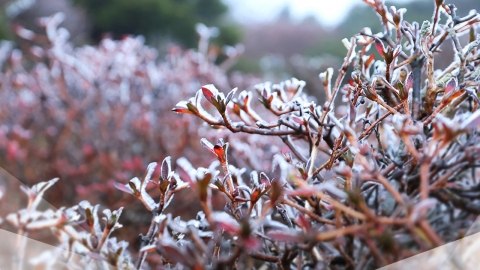Another disaster brought about by warming? ...Iceland Trembling With Volcano Eruption
[Anchor]
Often referred to as the "Land of Fire and Ice," Iceland, which boasts beautiful landscapes, has been warned that it faces an unprecedented crisis due to global warming.
A full investigation has been launched at the national level after analysis showed that volcanic activity is intensifying again due to the melting of massive glaciers.
I'm a YouTube reporter on the report.
[Reporter]
It is a representative volcano in Iceland that caused a huge eruption in 1875.
It's been quiet for the last 60 years, but there's been a drastic change from a few years ago.
It began to swell at a rapid pace, and the surface of the earth rose as much as 80cm over three years.
This phenomenon occurred when a huge amount of magma flowed under the volcano.
Some scientists are evaluating these changes as a result of global warming.
The melting of glaciers that pressed the crust with enormous weight lowers the pressure of the mantle below the crust, making magma easier.
[Eric Stuckel / Geophysicist at the University of Gothenburg, Sweden] Inside an unopened bottle of champagne, you can see bubbles. The principle is that when you open the cork and lower the pressure inside, the gas melts in the liquid and expands as it comes out.
In fact, more than 10,000 years ago, it was confirmed that volcanic activity in Iceland increased 50 times shortly after the end of the last ice age.
Currently, about half of Iceland's 34 active volcanoes are covered by glaciers.
However, 16% of glaciers have disappeared in the past 130 years, and more are lost every year.
If scientists' warnings become a reality and a large-scale chain of eruption occurs, Iceland will face a national crisis.
[Michelle Parks / Icelandic Meteorologist] Glaciers now make up about 10 percent of Iceland, and they are retreating as a result of global warming. This situation can affect volcanic activity in many ways.
Iceland is not the only volcano that has been crushed by huge ice.
More than 240 volcanoes, from Alaska in the United States and the Kamchatka Peninsula in Russia to the Andes Mountains and Antarctica, lie in a similar environment.
In particular, in Antarctica, where there are at least 100 volcanoes, 150 billion tons of ice is disappearing annually, which can exceed the threshold at any time.
It's YTN YouTube.
Edit
video: Han Kyung-hee
※ 'Your report becomes news'
[Kakao Talk] YTN Search and Add Channel
[Phone] 02-398-8585
[Mail] social@ytn.co.kr
Often referred to as the "Land of Fire and Ice," Iceland, which boasts beautiful landscapes, has been warned that it faces an unprecedented crisis due to global warming.
A full investigation has been launched at the national level after analysis showed that volcanic activity is intensifying again due to the melting of massive glaciers.
I'm a YouTube reporter on the report.
[Reporter]
It is a representative volcano in Iceland that caused a huge eruption in 1875.
It's been quiet for the last 60 years, but there's been a drastic change from a few years ago.
It began to swell at a rapid pace, and the surface of the earth rose as much as 80cm over three years.
This phenomenon occurred when a huge amount of magma flowed under the volcano.
Some scientists are evaluating these changes as a result of global warming.
The melting of glaciers that pressed the crust with enormous weight lowers the pressure of the mantle below the crust, making magma easier.
[Eric Stuckel / Geophysicist at the University of Gothenburg, Sweden] Inside an unopened bottle of champagne, you can see bubbles. The principle is that when you open the cork and lower the pressure inside, the gas melts in the liquid and expands as it comes out.
In fact, more than 10,000 years ago, it was confirmed that volcanic activity in Iceland increased 50 times shortly after the end of the last ice age.
Currently, about half of Iceland's 34 active volcanoes are covered by glaciers.
However, 16% of glaciers have disappeared in the past 130 years, and more are lost every year.
If scientists' warnings become a reality and a large-scale chain of eruption occurs, Iceland will face a national crisis.
[Michelle Parks / Icelandic Meteorologist] Glaciers now make up about 10 percent of Iceland, and they are retreating as a result of global warming. This situation can affect volcanic activity in many ways.
Iceland is not the only volcano that has been crushed by huge ice.
More than 240 volcanoes, from Alaska in the United States and the Kamchatka Peninsula in Russia to the Andes Mountains and Antarctica, lie in a similar environment.
In particular, in Antarctica, where there are at least 100 volcanoes, 150 billion tons of ice is disappearing annually, which can exceed the threshold at any time.
It's YTN YouTube.
Edit
video: Han Kyung-hee
※ 'Your report becomes news'
[Kakao Talk] YTN Search and Add Channel
[Phone] 02-398-8585
[Mail] social@ytn.co.kr
[Copyright holder (c) YTN Unauthorized reproduction, redistribution and use of AI data prohibited]
Editor's Recomended News
-
Arrested the publisher of "Yatap Station Murder Threat"..."I want to increase the number of visitors".

-
Myung Tae-kyun and Kim Young-sun summoned for the first time since their arrest.Attention is drawn to expanding the investigation into 'intervention in the nomination'

-
Consul General of New York, "Kim Gun-hee is not a military officer"...refutation of suspicion

The Lastest News
-
재생
 A four-car pileup on the way home from work...a series of highway accidents
A four-car pileup on the way home from work...a series of highway accidents -
재생
 Spring flowers all over the place.After the weekend, "Autumn is over." It's freezing cold.
Spring flowers all over the place.After the weekend, "Autumn is over." It's freezing cold. -
"Immediately stop military cooperation between North Korea and Russia" at President Yoon's APEC summit.
-
재생
 A vampire bat running on a treadmill...What is the surprising secret of the vampire bat?
A vampire bat running on a treadmill...What is the surprising secret of the vampire bat?








![[G-Star 2024] HiveIM's first outing raises expectations for new works](https://image.ytn.co.kr/general/jpg/2024/1115/202411151733271198_h.jpg)
![[G-Star 2024] Gravity, Main IP 'Ragnarok 3', etc. will be released for the first time.](https://image.ytn.co.kr/general/jpg/2024/1115/202411151613167158_h.jpg)